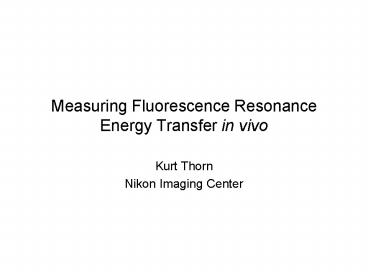Measuring Fluorescence Resonance Energy Transfer in vivo PowerPoint PPT Presentation
1 / 30
Title: Measuring Fluorescence Resonance Energy Transfer in vivo
1
Measuring Fluorescence Resonance Energy Transfer
in vivo
- Kurt Thorn
- Nikon Imaging Center
2
Fluorescence Resonance Energy Transfer
3
Good FRET pairs
- CFP/YFP use A206R mutants if dimerization is
problematic - GFP/mCherry or other FP pairs not so well
validated - Fluorescein/Rhodamine
- Cy3/Cy5 or Rhodamine/Cy5
- Many other small molecule pairs
4
Distance dependence of FRET
1
E
1 (r6/R06)
R06 ? k2 n-4 QD J(l)
Overlap between donor emission and acceptor
excitation
Donor quantum yield
Refractive index
Orientation between fluorophores
For CFP-YFP, 50 transfer at R0 4.9 nm
5
Transition dipole of GFP
Rosell and Boxer 2002 Inoue et al. 2002
6
Angular dependence of FRET
k2 depends on the relative orientations of the
donor and acceptor excitation dipoles. k2 ranges
between 0 and 4 and is 0 for whenever the donor
and acceptor dipoles are perpendicular to one
another. For rapidly-rotating dyes k2 2/3
R6 ? n-4 QD J(l)
1
E
1 (r6 / R6k2)
7
FRET Theory
- k2 (cos qT 3 cos qD cos qA)2
- For rapidly tumbling molecules, can average over
all possible orientations to give k2 2/3 - But rotational correlation time for GFP is 16
ns fluorescence lifetime is 3ns
qA
Acceptor
qD
Donor
qT
Acceptor
Donor
8
Effects of FRET
- Donor lifetime shortened
- Acceptor emission depolarized
- Donor fluorescence quenched
- Acceptor fluorescence enhanced on donor excitation
9
Measuring FRET
- Donor lifetime shortened
- Can measure by fluorescence lifetime imaging, but
requires specialized instrumentation
10
Measuring FRET
- Acceptor emission depolarized
- Can measure by fluorescence polarization
microscopy
11
Measuring FRET
- Donor fluorescence quenched
- Acceptor fluorescence enhanced on donor
excitation - Can measure by donor recovery after acceptor
photobleaching - Easy, but very sensitive to degree of
photobleaching
12
Measuring FRET
- Donor fluorescence quenched
- Acceptor fluorescence enhanced on donor
excitation - Can measure by quantitative measurement of
acceptor enhancement on donor excitation
13
Types of FRET experiments
Intramolecular
Intermolecular
14
Types of FRET experiments
For intramolecular FRET, CFP and YFP are always
present in a 11 ratio Ratiometric imaging can be
used as a rough measure of the amount of energy
transfer
Intramolecular
15
Types of FRET experiments
For intermolecular FRET, the relative abundance
of CFP and YFP is not controlled and can change
over time. Ratiometric imaging is no longer
possible, and additional corrections are
necessary.
Intermolecular
16
Data Acquisition
Three things to measure
Donor Intensity
FRET Intensity
Acceptor Intensity
17
Data Acquisition
- Maximize signal-to-noise use high NA objective,
sensitive, low-noise camera, high-transmission
filters - Minimize shifts between wavelengths
- Fluor or apochromatic objective
- Multipass dichroic with external excitation and
emission filters
18
Image preprocessing
- Background subtraction
- Register images by maximizing correlation with
FRET image
19
Data Acquisition
Acquire sequential images of FRET, YFP, CFP, and
DIC
20
A problem crosstalk into FRET channel
Correct using measurements from CFP- and YFP-
only cells
Ex
Em
21
A problem crosstalk into FRET channel
- For strains with only CFP and YFP, FRETC 0
- FitFRETC FRETm - aCFP - bYFP - g
Typical values a 0.9 b 0.4
22
Crosstalk correction
23
Calculating FRET efficiency
Traditionally FD (DonorAcceptor)
E 1-
FD (Donor alone)
24
Calculating FRET efficiency
FRETC G FD
E 1 -
FD
G corrects for detection efficiencies of CFP and
YFP G QDFD / QAFA
25
One final issue Autofluorescence
We correct for autofluorescence in the FRET
channel by inclusion of g But we also need to
correct for autofluorescence in the donor channel
Correct donor autofluorescence by subtracting
median donor fluorescence of untagged cells
26
Data analysis procedure
Preprocessed microscopy data
Preprocessing Background subtraction Image
alignment by maximizing the correlation of donor
and acceptor with the FRET image. Typical shifts
are lt2 pixels
Donor only
Acceptor only
Both colors
Crosstalk calculation
Corrected FRET
Calculation of CFP autofluorescence
FRET Efficiency
All analysis is done with custom MATLAB software
27
Photobleaching
- Some dyes photobleach quite easily (prime
offenders fluorescein, YFP) - Correction procedures are available but are
non-trivial - Photobleaching can lead to peculiar artifacts
28
Spatial variation of efficiency
29
Illumination Uniformity
30
Additional reading
- Lakowicz, Principles of Fluorescence
Spectroscopy, Chapters 13-15 - Gordon et al. 1998, Biophys. J. 74 p. 2702-2713
- Berney and Danuser 2003, Biophys. J. 84
p.3992-4010 - Zal and Gascoigne 2004, Biophys. J. 86 p
3923-3939 - Contact me for a MATLAB package that implements
this analysis

